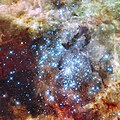File:Hubble Watches Star Clusters on a Collision Course - Flickr - NASA Goddard Photo and Video.jpg

Dimensioni di questa anteprima: 600 × 600 pixel. Altre risoluzioni: 240 × 240 pixel | 480 × 480 pixel | 768 × 768 pixel | 1 024 × 1 024 pixel | 2 500 × 2 500 pixel.
File originale (2 500 × 2 500 pixel, dimensione del file: 1,68 MB, tipo MIME: image/jpeg)
Cronologia del file
Fare clic su un gruppo data/ora per vedere il file come si presentava nel momento indicato.
| Data/Ora | Miniatura | Dimensioni | Utente | Commento | |
|---|---|---|---|---|---|
| attuale | 21:29, 17 ago 2012 |  | 2 500 × 2 500 (1,68 MB) | Werieth | == {{int:filedesc}} == {{Information |Description=Image release August 16, 2012 Astronomers using data from NASA's Hubble Space Telescope have caught two clusters full of massive stars that may be in the early stages of merging. The 30 Doradus Nebula ... |
Utilizzo del file
La seguente pagina usa questo file:
Utilizzo globale del file
Anche i seguenti wiki usano questo file:
- Usato nelle seguenti pagine di ml.wikipedia.org:



